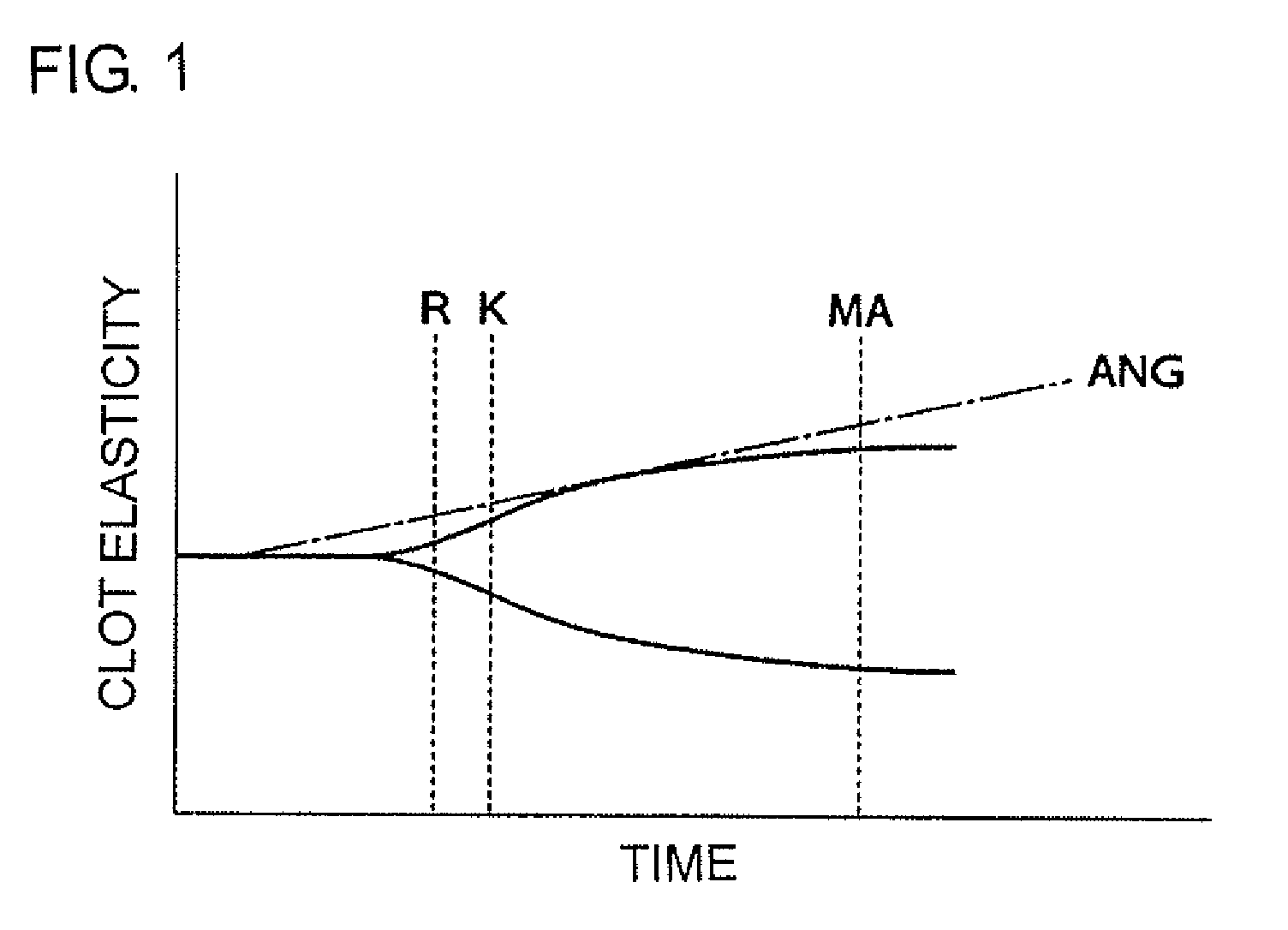Method for testing efficacy of antithrombotic agent
a technology of antithrombotic agent and method, which is applied in the field of method for can solve the problems of no method of assaying and and achieve the effect of quickly and easily testing the efficacy of an antithrombotic agen
- Summary
- Abstract
- Description
- Claims
- Application Information
AI Technical Summary
Benefits of technology
Problems solved by technology
Method used
Image
Examples
example 1
[0029]An example of the administration of aspirin as an antithrombotic agent will be described. First, 81 mg / day of aspirin was administered for three days. Blood sampled one hour after oral administration of 40.5 mg of aspirin thereafter was measured using a thromboelastograph. Specifically, thromboelastographic measurements were simultaneously carried out on the sampled blood itself, the same blood with 0.1 U / mL of heparin or 0.31 μg / mL of argatroban added, and blood obtained by adding 8.3 μM of ADP or 10 μg / mL of collagen to these. The measurement results are shown in Table 3.
[0030]
TABLE 3R valueASP(Control) 6.4 ± 1.5ASP + Hep22.8 ± 7.5ASP + Hep + ADP14.9 ± 8.1ASP + Hep + Col14.2 ± 6.3ASP + ARG20.3 ± 3.5ASP + ARG + ADP13.8 ± 3.6ASP + ARG + Col12.9 ± 3.2
[0031]Also, 660 mg / day of aspirin was administered for three days, and the blood sampled one hour after oral administration of 330 mg thereafter was measured in the same manner by using a thromboelastograph. The measurement results...
example 2
[0034]An example of the administration of sulpyrine will be described next. First, Table 5 shows the results of a thromboelastograph measurement when no sulpyrine was administered. The measurement was the same as in Example 1. Blood with 0.1 U / mL of heparin or 0.31 μg / mL of argatroban added and blood with 8.3 μM of ADP or 10 μg / mL of collagen added to these were measured simultaneously by using a thromboelastograph.
[0035]
TABLE 5R valueControl 6.3 ± 2.4Hep 26.4 ± 10.6Hep + ADP16.8 ± 8.1Hep + Col17.2 ± 7.8ARG29.8 ± 9.5ARG + ADP20.6 ± 2.9ARG + Col19.6 ± 5.6
[0036]Blood sampled one hour after intramuscular injection of 250 mg of sulpyrine with 0.1 U / mL of heparin or 0.31 μg / mL of argatroban added, and blood with 8.3 μM of ADP or 10 μg / mL of collagen added to these were measured simultaneously by using a thromboelastograph. The measurement results are shown in Table 6. When sulpyrine is not administered, the R value normally lengthened by heparin or argatroban is shortened by ADP and coll...
example 3
[0038]An example of the administration of Pletaal will be described next. First, as in Example 2, Table 7 shows the results of thromboelastograph measurements when no Pletaal was administered. The amounts of heparin, argatroban, ADP, and collagen added were the same as in Example 2.
[0039]
TABLE 7R valueControl 6.8 ± 2.4Hep28.6 ± 9.5Hep + ADP14.8 ± 8.4Hep + Col15.2 ± 7.6ARG 29.7 ± 10.5ARG + ADP19.5 ± 2.9ARG + Col20.8 ± 6.4
[0040]Blood sampled one hour after oral administration of 100 mg following administration of 200 mg / day of Pletaal for five days was measured using a thromboelastograph in the same manner as in Example 1. The measurement results are shown in Table 8. Blood with 0.04 U / mL of heparin or 0.06 μg / mL of argatroban added, and blood with 8.3 μM of ADP or 10 μg / mL of collagen added to these were measured simultaneously by using a thromboelastograph. When Pletaal was not administered, the R value normally lengthened by heparin or argatroban was markedly shortened by the addit...
PUM
| Property | Measurement | Unit |
|---|---|---|
| concentration | aaaaa | aaaaa |
| concentration | aaaaa | aaaaa |
| time | aaaaa | aaaaa |
Abstract
Description
Claims
Application Information
 Login to View More
Login to View More - R&D
- Intellectual Property
- Life Sciences
- Materials
- Tech Scout
- Unparalleled Data Quality
- Higher Quality Content
- 60% Fewer Hallucinations
Browse by: Latest US Patents, China's latest patents, Technical Efficacy Thesaurus, Application Domain, Technology Topic, Popular Technical Reports.
© 2025 PatSnap. All rights reserved.Legal|Privacy policy|Modern Slavery Act Transparency Statement|Sitemap|About US| Contact US: help@patsnap.com

